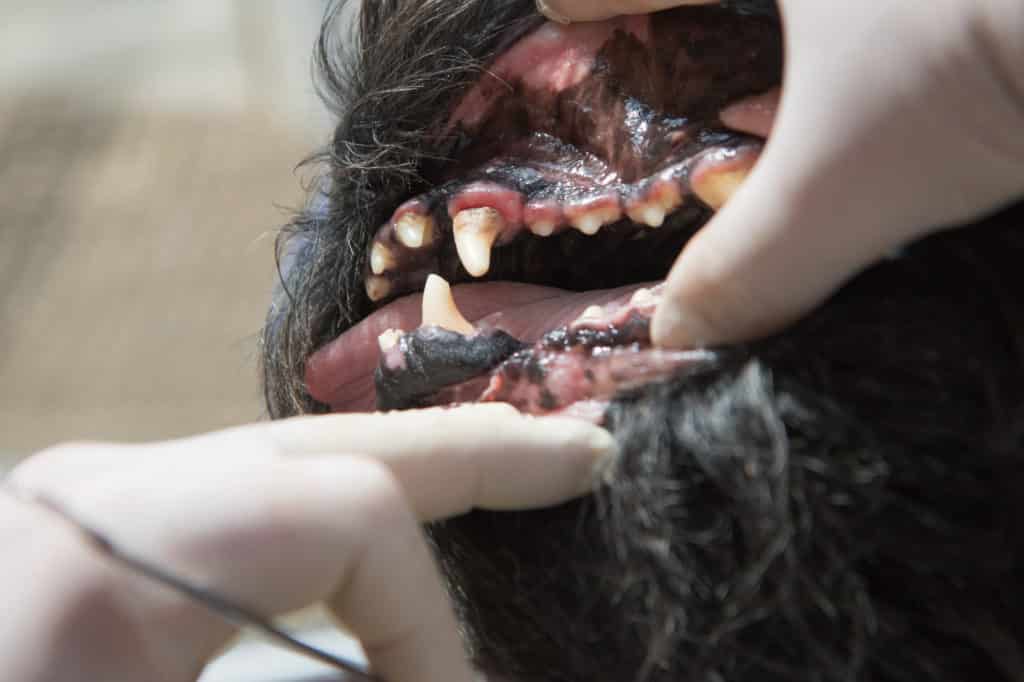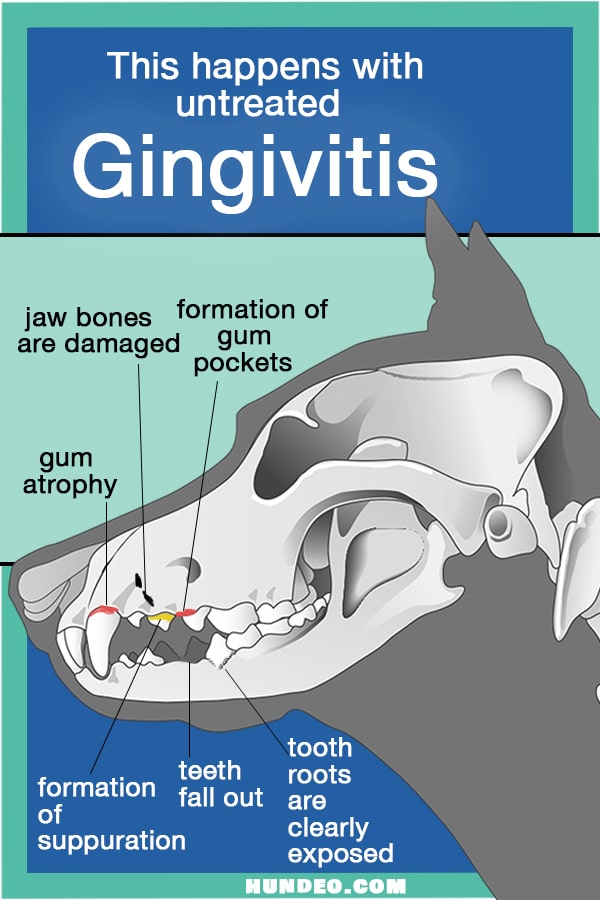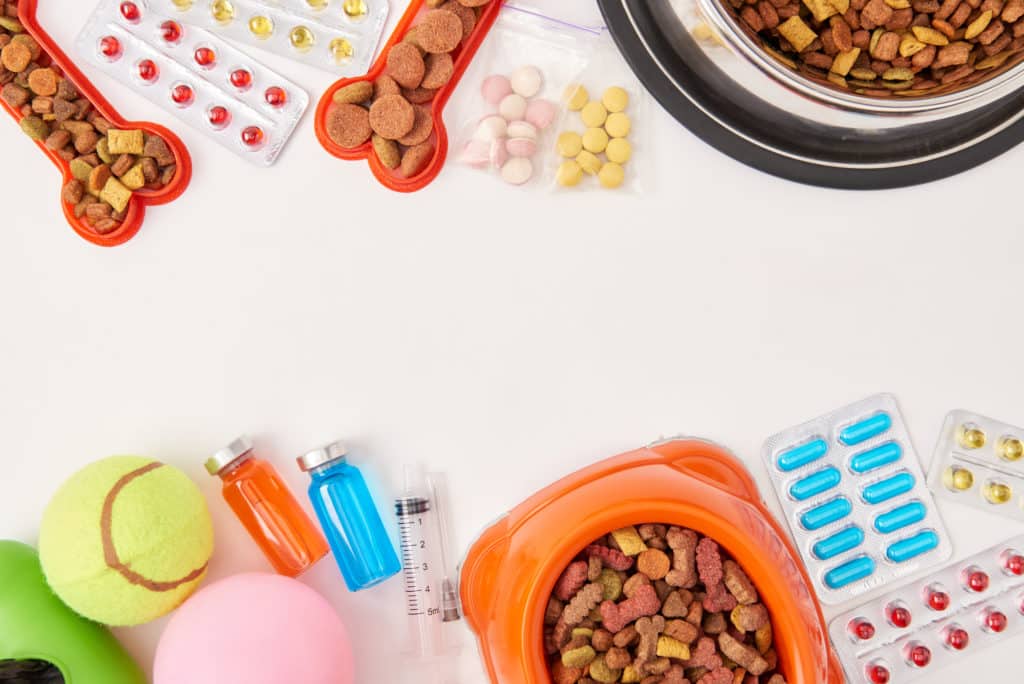Gingivitis in the dog? (Gingivitis Tips)
- Veterinarian Mag.med.vet. Emin Jasarevic
- Updated: 2023-04-12
It begins with seemingly harmless Bad breath and in extreme cases ends with the loss of teeth. How you can prevent this and what you should know about the topic, I'll tell you in this article. So be curious and take the time to read!

Gum inflammation in dogs, professional also Gingivitis are not a harmless matter. You should take them seriously. Untreated gingivitis often leads to periodontitis.
This is an extremely serious form of inflammation with fatal consequences.
A Periodontitis irreparably recedes the gums and the periodontium and attacks the jaw bones of your protégé. After some time, the teeth lose their support and fall out. Similar to humans, these diseases are associated with great suffering and severe pain.
In addition, persistent gingivitis with all its multiple consequences can also lead to organ damage.
So don't leave your dog alone with gingivitis!
We have chosen for this article Advice from veterinarian Mag.med.vet. Emin Jasarevic obtained. Note: This article is written for the german country.
What is gingivitis? (Gingivitis)
Gum inflammation in dogs is not a rare phenomenon.
In the course of their lives, up to 85 percent of all dogs contract gingivitis.
However, the causes of this clinical picture are very different. As a rule, it is a combination of different factors. In the long term, they lead to gingivitis. That is why gingivitis is also referred to as a multifactorial disease.
Among the decisive factors addressed are the Posture, the general living conditions of the animal, the Nutrition and genetic preconditions.
In the course of the disease, the gum line becomes inflamed, redness occurs and bleeding from the gums is more frequent.
In veterinary practice, gingivitis in dogs is classified in an index from zero to three. So the severity of the disease here has several levels.
What happens in untreated gingvitis?
- Gum recession
- Formation of gingival pockets
- Exposure of the tooth roots
- Suppuration formation
- Attacked jaw bones (parodonditis)
- Teeth failure
Since this is a large-scale inflammation, this process is Extremely painful.
In most cases, the disease takes a bad end if left untreated. Only in rare cases does gingivitis disappear on its own.
The consequences of gingivitis are considered reversible. This means that the damage can be repaired with reasonable treatment. Periodontitis, on the other hand, leaves permanent traces.
If, in the final stage, the jaw bone has already been attacked by extensive inflammation, it cannot be recovered.
Your darling would have to cope with the consequences for the rest of his life.

Causes
Larger dog breeds are mainly diagnosed at a later age, i.e. after the age of 5 or 6.
Of course plays the Nutrition of your four-legged friend plays an important role when it comes to the bacterial flora in his mouth. It is always recommended to give hard dog food regularly. Chewing and gnawing on hard dog cookies or bones will remove dental plaque. This also keeps the formation of tartar in check.
If you provide your furry friend with hard food on a regular basis, it is very likely that he will maintain a healthy mouth and teeth.
However, in some cases, dental hygiene is not responsible for the development of gingivitis. Also Tumors in soft mouth tissue can be the deciding factor here. General injuries in the mouth area of your quadruped also promote inflammation.
A regular checkup at the vet leads to a quick diagnosis and immediate treatment. For you as a dog owner, it is important to check your pet's mouth, teeth and gums yourself.
Symptoms

Since gingivitis is a complex inflammatory process, bacterial plaque plays a central role. This bacterial plaque is also referred to in dentistry as Plaque called. Just as in humans, plaque on the teeth can lead to gum inflammation in the long term.
It there are two types of bacterial plaque:
- It appears in a soft form at the beginning. With the help of good dental hygiene, these plaques can be easily removed. However, dogs have a natural antibacterial saliva that benefits them.
- The mineralized, i.e. solid form of bacterial plaque is called tartar. It must be removed by the veterinarian.
The extent of plaque formation depends on various factors. Each quadruped has an individual bacterial composition of the mouth flora.
Some breeds of dogs are genetically more prone to gingivitis. These breeds include in particular small dogssuch as Pug, Pekinese, Shi Tzu or Miniature Poodle. They may develop gingivitis at a young age.
The problem with gingivitis is that it seems extremely difficult to notice this disease in its early stages:
In most cases, your protégé will continue to eat as usual and will not show any unusual behavioral patterns or complaints. Here you must be very attentive. The only indication for gum inflammation is the distinctive mouth odor.
If the disease continues to progress unnoticed, the following symptoms will occur:
- purulent and bloody saliva
- Refusal of food
- Careful chewing or chewing on one side
- Weight loss
- Tooth loss
- Pain in the head and jaw
- Rubbing the head on the floor
- Holding the head between the paws
- Fever spikes
- Weaknesses
In the long term, gingivitis affects your pet on all levels. It can even damage internal organs, such as the heart or kidneys. The reason for this is bacteria that are washed out of the mouth deeper into your dog's body by the gum inflammation.
Diagnosis & Treatment
If gingivitis is suspected, your faithful companion needs to see a veterinarian immediately. He will be able to diagnose the disease and find out more about the severity.
Tartar can be removed with certain dental-medical devices. In complicated cases, treatment must take place in a specialized veterinary clinic. In the vast majority of cases, the normal veterinarian can provide assistance.
The type of treatment is decided based on the severity of the disease. If the gingivitis is mild, removal of the bacterial plaque is already often sufficient.
However, the entire oral cavity must be disinfected, as gingivitis is an extensive inflammation. It may therefore also be necessary to disinfect the areas in the gum pockets. There are special Saline and chlorhexidine rinses. The latter can also be rubbed into the gums as a gel.
Sometimes there is no choice but to extract the already loose teeth.
During the examination, the veterinarian also measures the recession of the gums and jawbone. The entire procedure is usually performed under general anesthesia of the animal.
Subsequent, but short-lived treatment with antibiotics may be given. This is especially the case if the bacteria from the oral cavity have already spread throughout the body and are attacking the internal organs.
There are even homeopathic approach methods to treat gingivitis in dogs. Some veterinarians offer this concept specifically. The most common substances include Calcium Sulfuratum, Sodium, Ferrum Phosphorum and Silicea. These can be applied separately or in combination.
How do I prevent?
Even with a hereditary predisposition, gingivits can be excellently prevented. This is where your care and attention counts.
Some dogs have impeccable teeth well into old age and absolutely no problems with bacterial plaque or tartar.
To ensure an active and lasting Dental care your protégé should be accustomed to it at a young age. There are two approaches here:
- Your darling should be sufficiently fed with hard dog food. In specialized stores there are special chewing bones, which are advertised directly under the teeth cleaning. Dogs need to chew, gnaw and bite intensively. This rubs off the unwanted plaque. Also, the increasing production of saliva rinses and disinfects the mouth.
- There are special brushes and toothpastes for active prophylaxis and teeth cleaning. The Toothpaste usually has a pleasant taste for your pet. However, you need to introduce him to it slowly and get him used to it. The sooner you start, the easier it will be for both of you.
To the general diet can be added that the so-called BarfenFeeding only raw and unprocessed food has proven to be a good prophylaxis against gingivitis.
Basically, you should make sure that your dog has to chew a lot and intensively. For example, as a dog owner, you can make sure that the chunks of dry food are so big that your fur bearer can't swallow them in one go. Then he will have to bite them and chew on them.
Which home remedies really help?

In case of gingivitis, only the vet can help!
However, if a certain amount of time needs to be bridged until the appointment, there are methods to ease your charge's pain and give them some strength.
Since your dog has discomfort when eating and may refuse food altogether, offer him food that he can eat easily and painlessly. There are special liver sausage for dogs. But also a little yogurt or cottage cheese will improve his morale. In principle, you can also use Gentle diet at first.
For pain relief chamomile tea is often used. You can give him the tea in a cooled state as a fresh water substitute. If he lets you do it, you can also try to actively rinse his mouth with the chamomile tea.
Frequently Asked Questions
Untreated gingivitis almost always worsens to the point where your dog can lose his teeth as a result. In addition, his internal organs can also be attacked. All this can lead to death.
Bad breath in your dog is a sign of too much plaque on the teeth or of tooth decay and gingivitis. In any case, you should take care of oral hygiene now.
To maintain your dog's dental health, brushing his teeth once a day is a recommended option. Also, you should provide him with enough chew toys, so he can help clean his teeth himself.
You will need a dog toothbrush and special toothpaste. Get your dog used to brushing his teeth slowly, without pressure and from an early age. You can find detailed step-by-step instructions in our article.
Your dog can get diseases in his mouth, just like humans, if his dental hygiene is neglected. These include tooth decay or gingivitis, which can cause pain.
Veterinarian’s Recommendation
Sometimes it happens that your dog suddenly has bad breath.
Unless you've recently changed his food or given him a snack he doesn't normally get, you should take this bad breath seriously.
This is because bad breath can not only be a sign of gingivitis, but can also indicate another disease in the mouth, throat or internal organs. That's why I advise you to call your veterinarian if you suspect anything.

I am a veterinarian and writer on animal health topics. Animals are my passion, and it is my personal goal to create medically accurate articles and videos to educate pet owners as much as possible.
Share Now:

